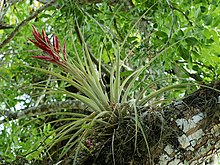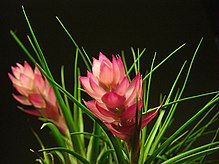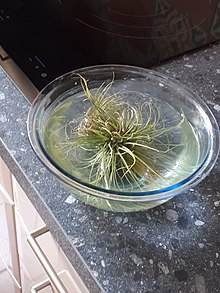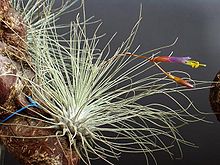Tillandsia
| Tillandsia | |
|---|---|

| |
| Tillandsia fasciculata | |
| Scientific classification | |
| Kingdom: | Plantae |
| Clade: | Tracheophytes |
| Clade: | Angiosperms |
| Clade: | Monocots |
| Clade: | Commelinids |
| Order: | Poales |
| Family: | Bromeliaceae |
| Subfamily: | Tillandsioideae |
| Genus: | Tillandsia L. |
| Species | |
| Synonyms[1] | |
| |
Tillandsia is a
They are also commonly known as air plants because they obtain nutrients and water from the air, not needing soil for nourishment. They have a natural propensity to cling to whatever surfaces are readily available: telephone wires, tree branches, bark, bare rocks, etc. Their light seeds and a silky parachute facilitate their spread.
Description

Tillandsia are
These leaf rosettes, a common physical characteristic in Tillandsia species, collect nutrients and water. The flowers typically involve bright, vibrant colors, with blooms or
Common pollinators of this genus include moths, hummingbirds and, more recently recognized, bats.[8]
Taxonomy
The genus Tillandsia was named by
- Tillandsia subg. Allardtia (A. Dietr) Baker
- Tillandsia subg. Anoplophytum (Beer) Baker
- Tillandsia subg. Diaphoranthema (Beer) Baker
- Tillandsia subg. Phytarrhiza (Vis.) Baker
- Tillandsia subg. Pseudalcantarea Mez, now raised to the genus Pseudalcantarea
- Tillandsia subg. Pseudo-catopsis Baker
- Tillandsia subg. Tillandsia
In a more recent (2016) classification, the following subgenera are recognized:[10]
- Tillandsia subg. Aerobia Mez in C.DC.
- Tillandsia subg. Anoplophytum (Beer) Baker
- Tillandsia subg. Diaphoranthema (Beer) Baker
- Tillandsia subg. Phytarrhiza (Vis.) Baker
- Tillandsia subg. Pseudovriesea Barfuss & W.Till
- Tillandsia L. subg. Tillandsia
- Tillandsia subg. Viridantha (Espejo) W.Till & Barfuss
Four species are protected under CITES II:[11]
Range

Tillandsia have naturally been established in diverse environments such as equatorial tropical rain forests, high elevation
Green-leaved species of Tillandsia generally live in cool-to-humid climates, in areas of terrestrial shade or the lower levels of a forest.
Ecology
Species of Tillandsia
Any root system found on Tillandsia has grown to act as a fragile stabilizing scaffold to grip the surface they grow on. As soon as they have been soaked with water, the green assimilation tissue below the suction scales becomes visible again, the plant is therefore "greened". Now the plant can absorb more light. When the sun dries the plants, they turn white. Thanks to this special survival trick, plants without roots can absorb fog droplets as well as rainwater and thus cover their water needs.[17]
More than one-third of a tropical forest's vascular plants are epiphytes which species of Tillandsia are part of. Their contribution to the environment's carrying capacity allows for terrestrial fauna like earthworms to thrive in the treetops.[18]
Temperature is not critical, the range being from 10 to 32 °C (50 to 90 °F). Frost hardiness depends on the species.
Cultivation


Tillandsias, like other bromeliads, can multiply through pollination and seed formation. Since Tillandsia are not self-fertile, the pollen must come from another plant of the same species. Tillandsia, depending on the species, may take months or years to flower. After flowering, the plant forms offsets and dies.[20]
Generally, the thinner-leafed varieties grow in rainy areas and the thick-leafed varieties in areas more subject to drought. Most species absorb moisture and nutrients through the leaves from rain, dew, dust, decaying leaves and insect matter, aided by structures called trichomes.[21] Air plants are growing rapidly in popularity as a low maintenance household plant. Due to their minimal root system and other adaptations, they generally do not require frequent watering, no more than four times a week, allowing the plant to completely dry before watering again.[22]
The amount of light required depends on the species; overall, air plants with silver dusting and stiff foliage will require more sunlight than air plants with softer foliage. They generally need a strong light. In summer outside, however, they prefer the light shade of a tree at the hottest hours. Plants are commonly seen mounted, placed in a
As of 2023[update] there are 34 cultivars of bromeliad registered by Bromeliad Society International, from T. Bacchus to T. Yabba.[26]
Gallery
-
Tillandsia recurvata and another Bromeliaceae species on electric wires near San Juan de los Morros, Venezuela
-
Tillandsia ionantha with bright-coloured foliage during full bloom. Some foliage has a light, silver dusting which can be easily scratched off
-
Tillandsia ionantha in bloom
-
Tillandsia fasciculata
-
Tillandsia bergeri
-
Tillandsia, 2018 Taichung World Flora Exposition, Taiwan
-
Tillandsia streptophylla growing on a limestone rock
-
Seed pods on T. ionantha in the center of the rosette
References
- ^ "World Checklist of Selected Plant Families".
- ^ . Retrieved 9 February 2023.
- ^ USDA, NRCS (n.d.). "Tillandsia". The PLANTS Database (plants.usda.gov). Greensboro, North Carolina: National Plant Data Team. Retrieved 10 December 2015.
- ^ Benzing, D. 2012. Air Plants: Epiphytes and Aerial Gardens. Ithaca: Comstock Publishing Associates.
- ^ Galán de Mera, A., M. A. Hagen & J. A. Vicente Orellana (1999) Aerophyte, a New Life Form in Raunkiaer's Classification? Journal of Vegetation Science 10 (1): 65–68
- ISBN 0-88192-604-3)
- ^ Lyman B. Smith , RJ Downs: Tillandsioideae (Bromeliaceae). In: Flora Neotropica , vol. 14, 2, 1979, p. 665.
- ^ Aguilar-Rodríguez, P., Macswiney, C., Krömer, T., García-Franco, J., Knauer, A., Kessler, M. March 2014. First record of bat-pollination in the species-rich genus Tillandsia (Bromeliaceae). Annals of Botany. Vol. 113(6) pp. 1047–1055.
- S2CID 86162509. Archived from the original on March 23, 2015.)
{{cite journal}}: CS1 maint: unfit URL (link - ISSN 1179-3163.
- ^ "Appendices I, II and III valid from 5 February 2015*". CITES. Retrieved 23 February 2015.
- ^ "Tillandsia L. | Plants of the World Online | Kew Science". Plants of the World Online. Retrieved 2022-03-04.
- ISBN 0-7137-0845-X)
- ISBN 3-8001-6501-5
- ISBN 9780521048958.
- JSTOR 2483646.
- ISBN 3-89745-155-7
- ISBN 9780801463877.
- JSTOR 2423907.
- ISBN 3-8001-3222-2.
- ISBN 978-1-86962-127-8.
- ISBN 3-89440-038-2.
- ISBN 2-84138-245-1)
- ^ Hayland, Lindsey (31 May 2019). "How To Water Air Plants The Right Way To Keep Your Air Plant Alive". Urban Organic Yield.
- ^ Instructions: Care for Air Plants (Tillandsia). Wedgewood Gardens. Available from: http://www.wedgewoodgardens.com/Care_Sheet_-_Air_Plants.pdf
- ^ "BCR Bromeliad Cultivar Register>". BSI (in Lithuanian). 19 February 2011. Retrieved 11 October 2023.
External links
 Media related to Tillandsia at Wikimedia Commons
Media related to Tillandsia at Wikimedia Commons








